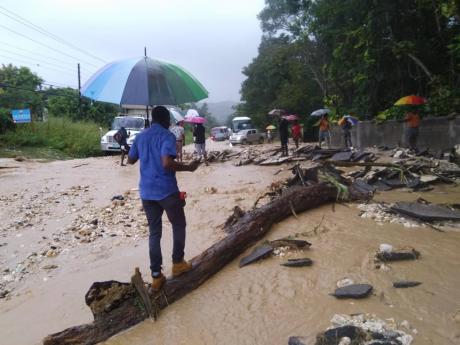Theresa Rodriguez-Moodie | Why Montego Bay floods
The recent rains and flooding in Montego Bay reminded me of a project I worked on four years ago that required me to walk along North Gully, one of three major gullies in Montego Bay. Heavy rains had caused major flooding in the city, and the authorities were trying to identify the primary cause(s) and possible solutions. It was not the first time Montego Bay had to deal with flooding, but with increased development taking place in the urban centre, the impact this time around was particularly devastating.
As I toured the gully, I noticed that despite the recent rains, there were mounds of garbage in the gully, primarily plastic bottles and diapers. There were also sections where garbage was left by the receding flood waters, entangled in shrubs, tall grasses, and the lower branches of tall trees. Houses, bars, shops, and garages crowded the length of the gully, and in some sections, housing was extremely dense. The gully looped in different directions, sometimes wide, sometimes very narrow, sometimes concrete, sometimes just bare earth. There was a flood gauge in one section that the community could use to monitor the height of the water to know when it was too dangerous for them to remain in their homes. The houses in this particular area were literally right against the banks of the gully. Despite being repeatedly affected by the overflowing waterways, numerous residents said this was all they could afford and they had been there for many decades.
FLOODED MULTIPLE TIMES
Over the last two decades, Montego Bay has flooded multiple times, with major flooding taking place in 2007, 2016, 2017, 2021, and more recently in April 2022. Significant flooding also took place in 1985 and 1993. Each time flooding occurred, there was a flurry of discussion by those in charge. Sometimes there was the blame game: it’s the improper disposal of solid waste; it’s the design of the gullies.
On my walk through this watershed and the surrounding communities, in conversation with several key community leaders and residents, and in reviewing reports, I learnt the following:
• The Montego Bay watershed has four major water courses. Three of these, Salt Spring Gully, North Gully and South Gully, are natural streams, but their lower courses have been trained, armoured, and concreted. These three gullies have been the primary source of flooding in Montego Bay.
• Sections of the gullies have ‘choke points’, where the watercourse narrows, restricting the flow of water, resulting in overtopping and flooding of the surrounding areas. These points are often made worse with washed-down sediments, garbage, and vegetation that further restrict water flow in the gullies.
• There is widespread human encroachment on the banks of these gullies with many houses and businesses. This means that they are very likely to be adversely affected once the gullies overflow.
• Over the years, significant housing development has taken place in the upstream sections of the catchments, resulting in removal of forest and vegetation and increased paved and hard surfaces. This has, in turn, increased the risk of flooding downstream because run-off is more significant, and water flows harder and faster.
Flooding in Montego Bay often occurs after intense rainfall over a short period of time, exacerbated by poorly designed and inadequate drainage infrastructure and carelessly discarded solid waste and debris (both domestic and commercial).
The Jamaica Environment Trust (JET) tried, in 2015, to better understand the solid-waste issues in the South Gully. JET learnt that the bulk of the solid waste was domestic, originating from formal and informal settlements along its banks. Poor disposal practices and insufficient garbage collection were highlighted as the main reasons. Several recommendations were made to address the solid waste management issues. These included clarifying which government entity was responsible for maintaining the gullies, establishing regular cleaning schedules, increasing frequency of garbage collection, and increasing the number of skips along established garbage routes. Public education and enforcement of anti-litter laws were also highlighted as critical interventions. These recommendations are still relevant today.
SEDIMENT CONTROL
Major damage from 25-year flood events could be alleviated and/or prevented with good sediment control, effective debris management practices, and proper maintenance of the gully system to ensure that the drainage channel is cleared and free of debris prior to and immediately following major rainfall events. The real problem, however, is with the larger events – the 50-year and 100-year events. Climate change projections and models suggest that these larger events will occur more frequently, resulting in escalating loss and damage.
The risks of the climate crisis are well known, but Jamaica’s development practices remain unchanged. Informal settlements continue to flourish on the edge of gullies, housing developments are being approved and built in the upper catchments of these watersheds, garbage disposal is ad hoc, and garbage infrastructure and collection are inadequate.
Some of the necessary solutions for Montego Bay, such as the re-engineering of the gully infrastructure and the relocation of the houses and businesses built along the banks of the gullies, are not quick fixes. But there are actions that can be implemented immediately. These include the provision of adequate garbage skips in communities, regular scheduled collection, enforcing the anti-litter laws, and replanting in the upper catchment areas. Primarily, however, we must stop repeating the same mistakes over and over again. We must stop allowing developments without the adequate setback from waterways; developments with overuse of hard surfaces; developments without climate screening and the necessary studies, associated infrastructure and drainage upgrades that focus on cumulative impacts. If these things are not done, Montego Bay will continue to flood more and more frequently.
- Theresa Rodriguez-Moodie, PhD, is an environmental scientist and CEO of the Jamaica Environment Trust. Send feedback to columns@gleanerjm.com.


